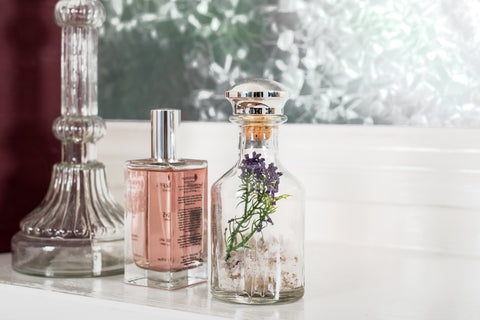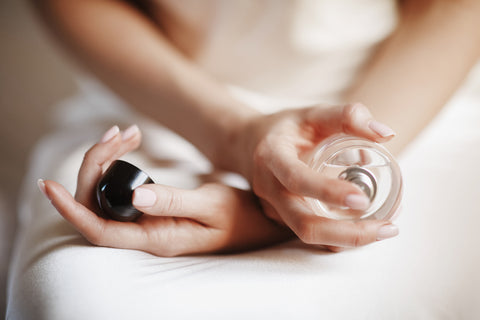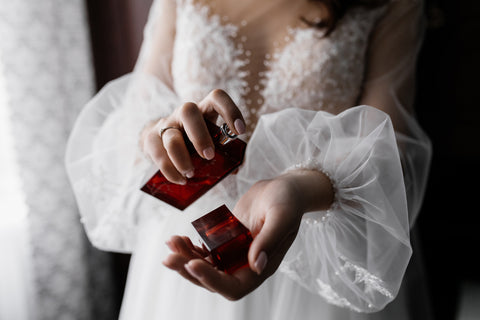Imagine Cleopatra, the legendary Egyptian queen, captivating audiences with her signature scent of crushed roses and spices. For centuries, perfumes have held the power to transport us, evoke emotions, and leave a lasting impression. Whether you're a seasoned fragrance enthusiast or just embarking on your olfactory journey, this comprehensive guide empowers you to maximize the potential of your newly acquired perfume. By delving into proper application techniques, exploring ideal storage methods, and offering additional considerations, this guide equips you with the knowledge to unlock the full potential of your fragrance and ensure a captivating olfactory experience.

Proper Storage: Ensuring Fragrance Longevity
Proper storage is essential for preserving its original scent, potency, and longevity. Just as delicate artwork requires specific conditions to maintain its beauty, so too does your precious fragrance. Let's delve into the enemies of perfume and the ideal storage practices to ensure your scent remains captivating for years to come.
The Enemies of Perfume
These environmental factors can negatively impact your perfume's quality and lifespan:
- Heat and Light: Both direct sunlight and extreme temperatures are detrimental to perfumes.
- Heat: Accelerates the evaporation of volatile fragrance molecules leading to a weaker and altered scent profile. Additionally, high temperatures can break down the chemical structure of the fragrance, contributing to a faster decline in quality.
- Light: Exposure to light, particularly UV rays, can trigger chemical reactions within the fragrance, causing it to degrade and lose its original character. This is especially true for photosensitive fragrance compounds.
- Humidity and Moisture: While occasional exposure to humidity is unlikely to cause significant damage, prolonged storage in humid environments can negatively impact your perfume.
- Moisture: Can dilute the fragrance and contribute to the growth of mold or bacteria in the bottle, potentially compromising the scent and safety of the product.
- Air Exposure: Frequent contact with air can accelerate the oxidation of the fragrance molecules, leading to a loss of potency and a potential change in its scent profile.
Ideal Storage Locations
Understanding the enemies of perfume allows us to identify the most suitable storage locations:
- Cool, dark drawers or cabinets: These sheltered areas offer minimal exposure to light and temperature fluctuations, providing ideal conditions for preserving your perfume's integrity.
- Original box: Although not essential, storing your perfume in its original box can offer additional protection from light and dust, further extending its lifespan.
- Vanity cabinets: While convenient, exercise caution if your vanity is located in a bathroom. The fluctuating temperature and humidity in bathrooms can be harmful to your fragrances.
Additional Tips
- Store upright: This helps prevent leakage and ensures proper distribution of the fragrance within the bottle.
- Avoid storing near heat sources: Keep your perfumes away from radiators, vents, and windows with prolonged sunlight exposure.
- Refrigeration (with caution): While some argue that refrigeration can further extend the life of perfume, it's crucial to approach this option with caution. The coldness can thicken the fragrance oil, impacting its sprayability. Additionally, condensation upon temperature changes can introduce moisture and potentially damage the perfume. If you choose to refrigerate, opt for the crisper drawer with minimal temperature fluctuations and store the perfume in its original sealed box to minimize moisture exposure.
- Travel Considerations: When traveling, consider these tips:
- Decant into travel-sized containers: Opt for refillable travel atomizers specifically designed for transporting fragrances. These smaller containers minimize air exposure and prevent potential leaks or spills.
- Protective packaging: Wrap your travel atomizers in bubble wrap or padding to provide additional protection during travel.
By following these simple yet effective storage practices, you can ensure your cherished fragrances remain as captivating and vibrant as the day you purchased them, allowing you to enjoy their olfactory magic for longer. Remember, proper storage is an essential expression of valuing your perfume and maximizing your olfactory investment.

Understanding Your Perfume
Delving deeper into your newly acquired fragrance requires understanding its fundamental aspects: concentration, fragrance families, and your unique skin chemistry.
Concentration and Fragrance Families
- Concentration: This term refers to the percentage of pure fragrance oil (parfum) present in the fragrance solution. As the concentration increases, so does the scent's strength and longevity, typically impacting the price as well. Here's a breakdown of common concentrations:
- Parfum (Extrait de Parfum): The most concentrated form (15-40% fragrance oil), offering the strongest and longest-lasting scent, typically lasting 6-8 hours or more.
- Eau de Parfum (EDP): Contains 8-15% fragrance oil, providing a noticeable scent that lasts 4-6 hours. This is a popular choice for its balance of strength and longevity.
- Eau de Toilette (EDT): Contains 4-8% fragrance oil, resulting in a lighter and shorter-lasting scent, typically around 2-4 hours. Ideal for everyday wear or warmer climates.
- Eau de Cologne (EDC): The least concentrated (3-5% fragrance oil), offering a refreshing and subtle scent that lasts 1-2 hours.
- Fragrance Families: Perfumes are further categorized into fragrance families based on their dominant scent characteristics. This classification system helps you explore scents based on your preferences and provides a general understanding of the fragrance profile. Some of the major fragrance families include:
- Floral: Characterized by the presence of floral notes like rose, jasmine, and lavender. These scents can range from light and delicate to rich and heady.
- Oriental: Warm and sensual fragrances featuring notes like amber, vanilla, and spices. They are often rich and complex.
- Woody: Earthy and comforting scents with notes like sandalwood, cedarwood, and vetiver. These fragrances evoke a sense of nature and stability.
- Fresh: Uplifting and invigorating scents dominated by citrus notes like lemon, bergamot, and grapefruit. They are perfect for daytime wear or warmer weather.
Understanding Your Skin Chemistry
An often overlooked but crucial factor in your perfume experience is your individual skin chemistry. This unique combination of factors influences how a fragrance interacts with your skin, impacting both the scent perception and its longevity.
- Skin pH: The acidity or alkalinity of your skin, measured on a scale of 1 (acidic) to 14 (alkaline), plays a significant role in fragrance breakdown. Ideally, your skin pH should be slightly acidic (around 5.5). However, factors like age, diet, and medications can influence this level.
- Tips for different skin types:
- Acidic skin: Fragrances may last longer due to slower breakdown. Opt for lighter fragrances or layering techniques to avoid overwhelming scent.
- Alkaline skin: Fragrances may break down faster, leading to shorter longevity. Choose stronger concentrations (EDP or Parfum) or reapply throughout the day to maintain the desired scent intensity.
- Diet and Medication: What you eat and medications you take can subtly alter the way a scent evolves on your skin.
- Diet: Strong spices like garlic or curry can introduce subtle background notes that can alter the fragrance's overall perception.
- Medication: Certain medications can affect the way your body processes and eliminates molecules, potentially influencing the scent's strength and character.
By gaining a deeper understanding of your perfume's concentration, fragrance family, and your unique skin chemistry, you can make informed choices, personalize your fragrance experience, and ensure your scent unfolds beautifully throughout the day.

Application Techniques for Optimal Results
Finding Your "Pulse Points"
- Understanding the Science: Explain the science behind "pulse points" and their role in fragrance diffusion. These areas have increased blood flow due to their proximity to arteries close to the skin's surface. As your blood circulates, it warms the applied fragrance, promoting better scent release and projection.
- Identifying Key Pulse Points:
- Wrists: A classic and convenient option. Apply a small spritz to the inner forearm, just below the wrist bone. Avoid rubbing your wrists together, as this can break down the fragrance molecules.
- Inner Elbows: Another area with good circulation. Apply a single spritz to the inner crook of your elbow.
- Neck: This area can project the scent subtly, especially when wearing a low neckline. Apply a light spray towards the base of your neck, avoiding direct contact with the delicate skin.
- Behind the Ears: This warm area offers good diffusion. Apply a single spritz behind each earlobe, being mindful not to spray directly onto your ears.
Mastering Spraying Techniques
- Maintaining a Proper Distance: Explain how distance impacts fragrance application.
- Too close: Leads to over-application, creating an overwhelming scent and potentially wasting perfume.
- Too far: Results in a weaker scent and less effective diffusion.
- Recommend a distance of 6-8 inches between the nozzle and your target area for optimal distribution.
- Spraying into the Air and Walking Through the Mist: This technique is ideal for a lighter and more subtle application.
- Gently mist the perfume into the air in front of you.
- Walk through the mist allowing the fragrance to settle gently on your clothes and hair. This minimizes the risk of over-application and creates a more diffused scent effect.
- Applying to Clothing: While not the preferred method, applying perfume directly to clothing can be an option, especially for delicate fabrics that may not react well with alcohol-based fragrances.
- Choose natural fibers like cotton or silk, as synthetic fabrics can trap and distort the scent.
- Test the fragrance on an inconspicuous area of the garment first to ensure it doesn't stain or damage the fabric.
- Apply a minimal amount at a safe distance to avoid saturation and potential staining.
- Remember, applying to clothing will likely shorten the fragrance's longevity compared to applying on pulse points.
Layering Techniques
- The Art of Fragrance Layering: Explore the world of layering, where you combine multiple fragrances to create unique and personalized scent profiles.
- Complementary Notes: Explain the key to successful layering lies in choosing fragrances with notes that complement each other.
- Identify the dominant notes (top, middle, base) in each perfume you want to layer.
- Aim for harmonious combinations:
- Layer fragrances with similar base notes for a cohesive and long-lasting scent.
- Combine contrasting notes like a fresh citrus scent with a warm vanilla scent for an interesting and dynamic experience.
- Starting Light and Layering Up: Recommend a cautious approach when layering.
- Begin with a light application of a fragrance with lighter and more volatile notes (e.g., citrus, floral).
- Gradually layer on scents with heavier and longer-lasting notes (e.g., amber, musk) to build complexity without overwhelming the senses.
Additional Tips
- Less is more: Always err on the side of caution and avoid over-applying fragrance. You can always add more later if needed.
- Reapply throughout the day: Touch-up with small sprays throughout the day to maintain the desired scent intensity.
- Consider the occasion: Choose your fragrance based on the occasion and desired effect. For example, opt for lighter and fresher scents for daytime wear and save heavier, more intense scents for evening occasions.
- Listen to your body: Pay attention to how your body reacts to certain fragrances. If you experience any irritation or discomfort, discontinue use.
By following these techniques and considering your personal preferences, you can master the art of applying perfume and enjoy a captivating and personalized olfactory experience.

Additional Tips and Considerations
Beyond the core aspects of understanding your perfume, proper application, and storage, here are some additional tips and considerations to elevate your fragrance journey:
Sample Before You Commit
- The Value of Samples and Decants: Purchasing a full-sized bottle of perfume can be a significant investment. To avoid costly mistakes and ensure you truly love a fragrance, consider trying samples or decants first.
- Samples: Many perfume retailers and online stores offer fragrance samples, allowing you to test a small amount on your skin and experience the scent's evolution throughout the day.
- Decants: If you find a fragrance you particularly enjoy from a sample, consider purchasing a decant. Decants are smaller, refillable containers that allow you to enjoy your favorite scent without the commitment of a full bottle.
Test on Your Skin
- The Uniqueness of Skin Chemistry: Remember, fragrance reacts differently on each individual's skin due to unique variations in skin chemistry. What smells divine on one person might not have the same effect on another.
- Testing Before Purchase: Always test the perfume on a small area of your inner arm or wrist before committing to a purchase. This allows you to assess how the fragrance interacts with your skin chemistry and identify any potential sensitivities.
Less is More
- The Power of Moderation: While you want your fragrance to be noticeable, it's crucial to avoid over-application. A gentle application ensures a pleasant and inviting scent experience, not an overpowering one.
- Start Light and Build: Begin with a single spritz on your pulse points and assess the intensity throughout the day. You can always add a touch more later if needed, but be mindful of overdoing it.
Reapplication Throughout the Day
- Understanding Fragrance Longevity: Different perfume concentrations (EDP, EDT, etc.) and individual skin chemistry factors will influence how long a fragrance lasts.
- Strategic Reapplication: To maintain a consistent scent presence throughout the day, consider reapplying a small amount of perfume to your pulse points as needed. This is especially important for lighter fragrance concentrations or if you have dry skin, which tends to absorb fragrance faster.
Letting Your Perfume Rest
- The "Resting" Period: While not scientifically proven, some fragrance enthusiasts believe that allowing a newly purchased perfume to "rest" for a few weeks before wearing it can allow the fragrance notes to settle and mature, potentially resulting in a smoother and more balanced scent experience.
Dealing with Unwanted Scents
- Accidental Spills and Overapplication: Accidents happen, and sometimes you might find yourself needing to remove unwanted perfume from your skin or clothing.
- For skin: Apply a small amount of rubbing alcohol or unscented hand sanitizer to a cotton ball and dab gently on the affected area. Avoid harsh scrubbing, as this can irritate the skin.
- For clothes: If the perfume hasn't set yet, blot the excess with a clean, absorbent cloth. For stubborn stains, pre-treat the area with a gentle laundry stain remover and follow the garment's care instructions for washing.
Ethical Considerations
- Aligning with Values: The fragrance industry is not without its ethical concerns. As a conscious consumer, you might consider researching the brand's practices and choosing perfumes that are cruelty-free and ethically sourced, aligning with your personal values. This could involve looking for brands that are certified cruelty-free and committed to sustainable and responsible sourcing of ingredients.
By implementing these additional tips and fostering a mindful approach to your fragrance experience, you can ensure your perfume journey is not only enjoyable but also aligns with your values and preferences. Remember, fragrance is a personal expression, and with the right knowledge and practices, you can unlock its full potential and leave a lasting olfactory impression.
Conclusion
This comprehensive guide has equipped you with the essential knowledge to explore the captivating world of perfume. From understanding your fragrance's composition and mastering application techniques to ensuring proper storage and exploring additional considerations, you now possess the tools to fully appreciate your new olfactory companion. Remember, just as a fine piece of art requires careful handling to preserve its beauty, so too does your perfume. By following these simple yet effective tips, you can ensure your fragrance retains its original brilliance and allows you to express your unique olfactory identity with confidence and delight.
Final Thought: "Perfume is a story in a bottle, waiting to be told." – John Steinbeck. Embrace the narrative your chosen fragrance unfolds and embark on a captivating olfactory journey.

